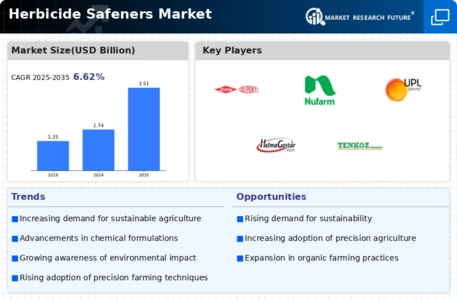Market Share
Herbicide Safeners Market Share Analysis
herbicide safeners market, companies implement various strategies to secure their positions and gain a competitive advantage in catering to the needs of farmers and the agricultural industry. Herbicide safeners, critical for protecting crops from the harmful effects of herbicides while maximizing weed control efficacy, require strategic positioning to effectively capture market share and address the demands of growers.
One of the primary strategies employed in the herbicide safeners market is product differentiation. Companies invest in research and development to create innovative herbicide safener formulations that offer unique benefits to farmers. These formulations may include safeners that enhance crop tolerance to herbicides, reduce phytotoxicity, and minimize crop stress, ultimately leading to improved yields and quality. By differentiating their products based on these desirable traits, companies can attract farmers seeking solutions to optimize herbicide application and protect their crops effectively.
Pricing strategy is also a crucial aspect of market share positioning in the herbicide safeners market. While the development and commercialization of herbicide safener technologies entail significant investment and research costs, companies must balance pricing to remain competitive. Some companies opt to compete based on price by optimizing production processes, minimizing overhead costs, and offering competitively priced herbicide safener products. This approach aims to appeal to cost-conscious farmers while still ensuring profitability and sustainability for safener producers.
Furthermore, companies often target niche markets or specific crop segments to tailor their herbicide safener strategies. For instance, companies may develop safener formulations tailored to specific crops such as corn, soybeans, wheat, or rice. Additionally, companies may focus on addressing particular challenges or needs prevalent in certain regions or farming systems, such as herbicide resistance management or environmental stewardship. By understanding the unique needs and preferences of different customer segments, companies can customize their herbicide safener offerings to provide targeted solutions effectively. This targeted approach allows companies to position themselves as leaders in specific crop segments and build strong relationships with farmers seeking tailored safener solutions.
Branding and marketing efforts also play a crucial role in market share positioning within the herbicide safeners market. Building a strong brand identity helps companies establish credibility, trust, and recognition among farmers, agricultural stakeholders, and industry professionals. Through effective branding, companies can communicate the benefits and value proposition of their herbicide safener technologies, distinguishing themselves from competitors. Additionally, targeted marketing campaigns highlighting the agronomic benefits, environmental safety, and economic advantages of herbicide safeners can influence purchasing decisions and drive demand in the market.
Moreover, strategic partnerships and collaborations are instrumental in expanding market share and enhancing competitive positioning in the herbicide safeners market. Collaborating with agricultural input suppliers, herbicide manufacturers, agricultural distributors, and extension services allows companies to leverage their combined expertise, resources, and networks to penetrate new markets and reach a broader customer base. Partnerships may involve joint research and development projects, licensing agreements, or distribution partnerships to accelerate the adoption and commercialization of herbicide safener technologies. By forging strategic alliances, companies can capitalize on synergies, expand their market reach, and strengthen their competitive position in the herbicide safeners market. herbicide safeners market is characterized by increasing demand for innovative solutions that maximize weed control efficacy while minimizing crop stress and phytotoxicity. To succeed in this competitive landscape, companies employ various market share positioning strategies, including product differentiation, pricing, niche targeting, branding, and strategic partnerships. By understanding the diverse needs of farmers, innovating to meet evolving market demands, and building strong relationships with stakeholders, companies can establish a competitive edge and thrive in the dynamic herbicide safeners market.









Leave a Comment